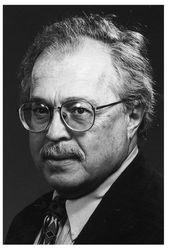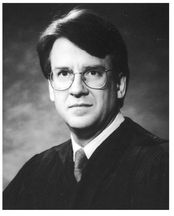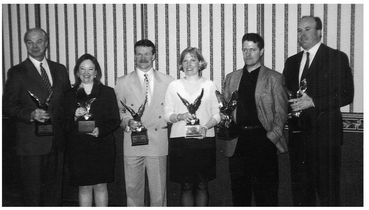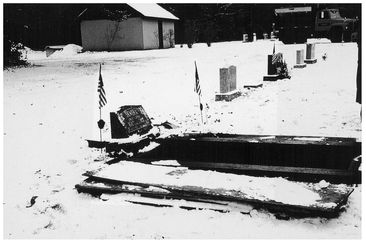Perfect Poison (50 page)
Authors: M. William Phelps


Dr. Michael Baden was asked by the Veterans Affairs Office of Inspector General to look at the medical files of VAMC patients who died during the seven years that Kristen Gilbert worked at the hospital.
(Courtesy Michael Baden)
(Courtesy Michael Baden)

Arrested on July 11, 1996, for breaking and entering into boyfriend James Perrault's apartment, Kristen Gilbert was photographed by the Easthampton Police Department.
(Courtesy VA-Inspector General's Office, Bedford, Massachusetts)
Under a federal grand jury subpoena, Kristen Gilbert was photographed by Special Agent Steve Plante on September 5, 1996, shortly after submitting to handwriting samples and fingerprinting.
(Courtesy VA-Inspector General's Office,
Bedford, Massachusetts)
Bedford, Massachusetts)


On November 24, 1998, for the first time in public, U.S. Attorney William Welch announced the indictment against Kristen Gilbert, which included three counts of murder.
(Courtesy Bruce Sackman)

United States Attorney Ariane Vuono, co-council to Bill Welsh, helped to convict Kristen Gilbert.

Judge Michael Ponsor later wrote that this case was “the most complicated and stressful thing [he'd] ever done...”
(Courtesy U.S. District Court of Mass.)

Glenn Gilbert, ex-husband of convicted serial killer Kristen Gilbert, leaves the Federal Building in Springfield, Mass, after appearing at a hearing in U.S. District Court on March 16, 2001.
(AP/Wide World Photos)

In the spring of 2001, the people most responsible for bringing Kristen Gilbert to justice were honored with the Eagle Award by the Veterans Affairs Office of Inspector General. From left: Massachusetts State Police Detective Kevin Murphy, R.N. Renee Walsh-Skwirz, Special Agent Steve Plante, R.N. Kathy Rix, R.N. John Wall, and U.S. Attorney William Welch.

Edward Skwira's grave before his remains were exhumed on November 27, 1997.
(Courtesy U.S. Attorney's Office, Springfield, Mass.)

The gravesite of Stanley Jagodowski shortly before his body was exhumed on July 13, 1998.
(Courtesy U.S. Attorney's Office, Springfield, Mass.)
Keep reading to enjoy an exclusive preview of
M. William Phelps's next true-crime book!
M. William Phelps's next true-crime book!
Â
Â
Obsessed
Â
On sale now!
CHAPTER 1
SUSAN RAYMUNDO WAS used to her daughter calling her Florida winter home at least twice a day. Anna Lisa was good that way. She liked to stay in close touch with her parents, even just to say hello, things are fine.
“She was a very thoughtful daughter,” Anna's father, Renato, later said. “She was a perfect daughter . . . an excellent human being.”
Smart too: Anna Lisa held a bachelor's degree from Harvard and a master's from Columbia University.
On November 8, 2002, retired pediatrician Susan Raymundo was at a local hospital near her Florida home with her mother, who was undergoing a routine procedure. When she returned to the house, Susan noticed the light on the answering machine blinking. During that ride home, Susan later recalled, she'd had an uneasy feeling. She couldn't put her finger on it, but something was nagging at her.
Something was wrong.
Tossing her keys on the counter, putting her handbag down, Susan hit the PLAY button and listened, knowing who it was.
Anna . . .
“Hi, Mom and Dad. I just want you to know what's going on. I know you're busy with Grandma, but I'll talk to you sometime.”
It was 10:34
A.M.
, Susan noticed, when the message came in.
A.M.
, Susan noticed, when the message came in.
After getting herself situated, Susan called Anna Lisa back. The line rang several times, but there was no answer.
Odd.
Anna worked from home on Fridays. She was always there, especially during the day. Susan and her husband had purchased the Connecticut condo for Anna Lisa, closing the deal back on March 15, 2000.
I'll try again later,
Susan told herself, perhaps subtly sensing, if only with a motherly intuition, that something was amiss. During the car ride home from the hospital, was that feeling she had related to Anna?
Susan told herself, perhaps subtly sensing, if only with a motherly intuition, that something was amiss. During the car ride home from the hospital, was that feeling she had related to Anna?
CHAPTER 2
THE WOMAN SOUNDED FRANTIC. She was in a terrible hurry. Inhaling and exhaling heavily, as if out of breath. Yet, strangely enough, she cleared her throat before speaking for the first time.
“Yes, hello. . . ,” the woman said after the Stamford Police Department (SPD) 911 dispatcher beckoned her to speak up. “Yes . . . the guy . . . the . . . he attacked my neighbor.”
“You mean someone attacked your neighbor?” dispatch asked as the caller blew two gasping, dramatic breaths into the receiver.
Whoosh . . . whoosh.
“Yes, yes. . . ,” the caller said, but she sounded sheepish, as if uncomfortable for some reason.
“When did this happen?” dispatch queried.
It sounded as if the caller said: “I saw a guy go into the apartment at 1-2-3 Harbor View . . .”
Dispatch noted the address. Then, not quite understanding, the police operator asked: “One twenty-six Harbor Viewâ”
But the caller interrupted, correcting the dispatcher in an angry tone, yelling over the dispatcher's voice: “One twenty-
three
Harbor View!”
three
Harbor View!”
“Okay,” dispatch said. “Don't yell, because I cannot understand you.”
Almost in tears now, the seemingly frantic 911 caller spoke once again over dispatch: “One twenty-three Harbor View.”
“Listen to me . . . 123 Harbor View . . . what is your friend's name?”
“I don't know her name, but she's my neighbor and she lives in apartment 1-0-5.”
“She lives in apartment 1-0-5?”
“Right! And the guy was in there, and he . . .”
“He what?”
“He
attacked
her.”
attacked
her.”
“Okay. Can you tell me what the guy looks like?”
“I just don't know. I heard yelling. I heard yelling.”
There was a clicking sound next.
“Hello?” dispatch said. “Hello? Hello?”
The line was dead.
This strange call, in its entirety, lasted one minute, thirty seconds.
CHAPTER 3
HE HAD JUST finished eating lunch. It was near 12:30
P.M.
, November 8, 2002âthat same Friday. The weather was rather mild for this time of the year near the Connecticut shoreline, the temperature ranging from 46 to 57 degrees Fahrenheit. The air was dry and sharp, a slight breeze, with winds of approximately six miles per hour rolling in off the Atlantic Ocean. The sun was bright and blinding. There was a waxing crescent moon (7/8 full), nearly visible in the illuminating blue skies. By all accounts, a resident could call it a picture-perfect late fall day in one of Connecticut's more prominent, upscale, seaside communities.
P.M.
, November 8, 2002âthat same Friday. The weather was rather mild for this time of the year near the Connecticut shoreline, the temperature ranging from 46 to 57 degrees Fahrenheit. The air was dry and sharp, a slight breeze, with winds of approximately six miles per hour rolling in off the Atlantic Ocean. The sun was bright and blinding. There was a waxing crescent moon (7/8 full), nearly visible in the illuminating blue skies. By all accounts, a resident could call it a picture-perfect late fall day in one of Connecticut's more prominent, upscale, seaside communities.
The cop drove a marked police cruiser. He was dressed in full uniform. The area that twenty-two-year veteran police officer David Sileo patrolled was indeed exclusive. Officers called it “District Three.” Stamford had seen a sharp economic resurgence in recent years; its downtown was revitalized and injected with a bit of vitalityâshops and businesses thriving. The bubble all around them might have burst, but Stamford seemed to be still floating. This particular region just outside downtown, where Officer Sileo headed, was known to locals as “Cove/ Shippan,” located south of Interstate 95, in between Cummings Park and Cove Island Park.
Yachts and fishing rigs and houseboats.
Money and status.
The dwelling at 123 Harbor Drive sat in an inlet, a cove, southwest of West Beach, just across the waterway from Dyke Park. It was not Harbor View, as the caller had suggested. People walked their dogs here. Docked their massive sailboats and Bayliners and Sea Rays, cruise liners and immense pleasure boats. Men and women jogged in expensive sweat suits, earbuds pushed in deeply for privacy, minding their own business. Families had picnics and tossed Frisbees, lay out in the sun when weather permitted. Stamford, Connecticut, by and large, is a wealthy region within a small state of 3 million-plus residents. Stamford is the sister to the more select, more elite, and perhaps even snootier Greenwich. By big-city standards, Stamford boasts a small population of about 120,000. Median income holds steady at $75,000. Taxes are high. The streets are mostly clean. Crime rates in certain areas are low. Housing prices fluctuate, depending on where a person wants to live within the city limits.
Officer Sileo was dispatched to 123 Harbor Drive, unit 105, specifically, after that strangely cryptic 911 call had been called in moments before, wherein an anonymous woman had maintained that a neighborâsomeone she apparently knewâwas being attacked by a man.
Those three facts were clear:
neighbor, attack, man.
neighbor, attack, man.
When Sileo arrived, another officer pulled up behind him. They agreed to knock on the door. See what the hell was going onâif anythingâinside the condo.
The unit at 105 Harbor Drive (not Harbor View) sat atop a three-car garage. Visitors walked up a few steps to the front door.
Officer Lawrence Densky, who had arrived as Sileo did, knocked on the screen door. Sileo looked into the condo through the side-window panels on the left side of the door.
Neither officer heard or saw anything.
So Sileo rang the doorbell.
They waited.
Nothing.
With no answer, Sileo attempted to open the door. He turned the knob.
It was unlocked.
Sileo watched as his colleague, Officer Densky, pushed the door open “a few inches,” took a quick peek inside, and then yelled, “Stamford Police . . . is anyone home?”
No response.
It was eerily quietâespecially for a domestic incident, the type of which had been called into 911. If two people were arguing, where were they?
Pushing the door fully open, Densky spied a ghastly sight, which prompted him to immediately draw his weapon.
Officer Sileo stood directly behind his colleague, hand on his sidearm.
Both cops made eye contact with each other and agreed silently with head nods to enter the condo slowly, barrels of their weapons leading the way.
Other books
School Days According to Humphrey by Betty G. Birney
The Tryst (Annotated) (Grace Livingston Hill Book) by Hill, Grace Livingston
BRIDAL JEOPARDY by REBECCA YORK,
Mortal Danger (The Immortal Game) by Ann Aguirre
The Renegade's Heart by Claire Delacroix
A Little Night Music by Andrea Dale, Sarah Husch
Spider’s Revenge by Jennifer Estep
2 Murder Most Fowl by Morgana Best
Close Your Eyes by Amanda Eyre Ward
Letters from Skye by Jessica Brockmole